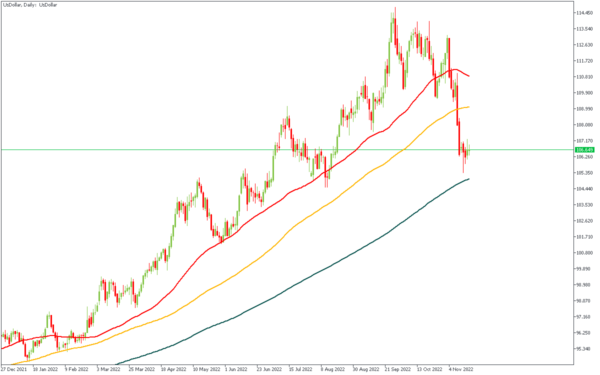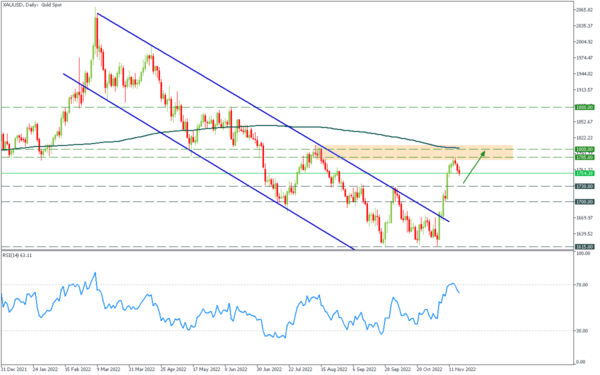Suddenly, the US Dollar Index fell 6.70% over the last two weeks, marking the biggest decrease in the currency since 2020. This movement greatly impacted stocks, other currencies, and gold. In this article, FBS experts focus on the XAUUSD pair as a main antagonist of the dollar. Economic analysis, valuable tips, and price forecasts are in this article.
What stands behind the dollar’s fallout?
The uptrend in the USD that lasted almost two years. It may now seem that the US currency is finally ready to reverse to the downside. The decrease started on November 4, when the US Office for National Statistics released the Non-farm employment change (NFP) data. The two previous releases pushed the USD up, that’s why it was surprising that high NFP pulled the USD down.
The US dollar strengthened after September’s and October’s NFP because the strong labor market signaled to the Fed that the American economy was still hotter than needed. Thus, it was evident that the Fed would increase the interest rate to decrease the speed of rising prices. In November, however, the sentiment started to change because NFP was still lower than in previous months, meaning that the labor market finally started to cool down.
The USD decrease sped up when the US monthly CPI data came out on November 10. A 0.4% rise vs. 0.6% forecast was taken as “the end of the recession,” sending risky assets to the moon and the USD below the 100-daily moving average. Finally, the US PPI, another measure of consumer inflation, turned out to be lower than expected (0.2% vs. 0.4% forecast).
All this created massive pressure on the US dollar index, pushing it to a three-month low and boosting EURUSD, stocks, and gold. Even so, why did gold skyrocket?
Gold and the USD interconnection
When Federal Reserve hikes rates, it makes money more expensive. To put it simply, higher interest rates increase deposit yields and loan interest. Thus, people and companies slow down spending and try to save more money for the future. The economy slows, and currency becomes more expensive, rising against other currencies. All that creates price pressure for gold, pushing it lower when the Fed fights inflation and insists on hawkish measures.
Here’s how it works:
- The inflation goes up, and the amount of the USD in circulation increases. Thus, the USD starts to decline.
- Fed applies monetary measures (interest rate increases and decrease of money supply)
- The USD starts growing, putting pressure on the XAUUSD (gold).
- The dollar weakens as the tightening process slows down, and gold soars.
The correlation between these two assets is better to see than to read about. Also, consider checking the FBS website for more analysis on gold and USD movements.
As for now, we have come to the most exciting part of the USD-gold price correlation, which is the change in the global trend.
Gold price forecast
Both the USD and XAUUSD approached the most important indicator of the trend – the 200-daily moving average. This level acts as a support for the dollar and as a resistance for gold. In both cases, the breakout of this level will signal a change in the long-term trend.
If the USD breaks the level of 105.00, gold will be extremely bullish. However, it’s important to notice that 200-period MA is a solid barrier. Assets usually take several attempts to break and form a price swing in the direction of the breakout. Therefore, we consider gold will correct from the area of $1785-1800 and reach the support of $1730, the last price high. After that, we need to look closely at actual economic data. More bearish news for the USD would add momentum to gold movements, and the metal may rise to $1880.
In summary, gold has more chances to grow than in the previous eight months. And with FBS, you can trade gold wherever you want, buying and selling the asset in seconds.











![Week ahead – ECB set to cut, BoC might pause as Trump U-turns on tariffs [Video]](https://www.actionforex.com/wp-content/uploads/2018/04/f-ecb29-218x150.jpg)



